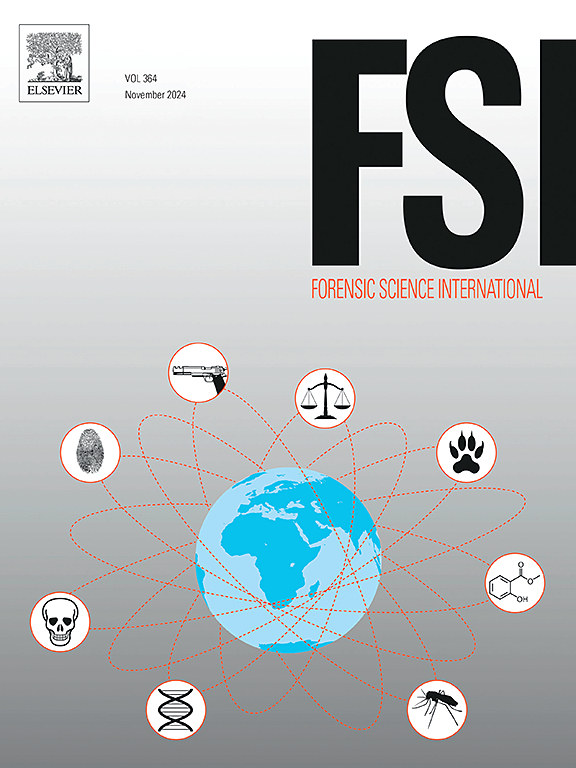手腕角度和手指握把对最大扳机拉力的影响
IF 2.2
3区 医学
Q1 MEDICINE, LEGAL
引用次数: 0
摘要
对手枪射击的法医调查可能需要对射击者的身体姿势进行分析,或者对射击是故意的还是无意的提出意见。确定扳机所能施加的力度或手枪指向的方向对调查至关重要。手臂姿势对全手最大握力影响的研究表明,最大食指握力将高度依赖于手腕角度和手指握力。本研究旨在量化这些因素对最大食指扳机拉力的影响。我们发现,即使在几乎最佳的条件下,触发拉力也会随着手腕弯曲而大大减少,并且与手指钩握相比,手指垫握的握法明显更低。我们的研究结果表明,当手腕屈曲角度大于60°时,与中性或伸展手腕相比,男性受试者的最大触发拉力下降了50% %,女性受试者的最大触发拉力下降了38% %。其他研究表明,当不能牢固地握力时,食指的最大力度可能小于我们测量的30% %。因此,在某些情况下,男性受试者的最大触发拉力可能低于22.9 N(5.1 lb),女性受试者的最大触发拉力可能低于19.0 N(4.5 lb)。如果一个实验对象不能牢牢地抓住手枪,而且手臂的姿势很尴尬,那么实验对象就有可能无法施加足够的食指力量来克服许多手枪的扳机重量。本文章由计算机程序翻译,如有差异,请以英文原文为准。
The effect of wrist angle and finger grip on maximum trigger pull force
A forensic investigation into a shot fired by a handgun may require analysis of the body posture of the shooter or an opinion of whether the shot was deliberate or inadvertent. Determining the amount of force which can be applied to the trigger or the direction in which the handgun was pointing could be critical to the investigation. Studies investigating the effect of arm posture on whole hand maximum grip force suggest that maximum index finger force will be highly dependent on wrist angle and finger grip. The present study was designed to quantify the effect of these factors on maximum index finger trigger pull force. We found that even under almost optimal conditions, trigger pull force is substantially reduced with wrist flexion and is significantly lower with a finger pad grip compared to a finger hook grip. Our results indicate that for wrist flexion angles greater than 60°, maximum trigger pull force dropped by 50 % for male subjects and by 38 % for female subjects compared to the neutral or extended wrist. Other studies have shown that when a firm grip cannot be established, maximum index finger force can be less than 30 % of what we measured. Thus, maximum trigger pull forces could be below 22.9 N (5.1 lb) for male subjects and 19.0 N (4.5 lb) for female subjects in certain scenarios. If a subject is unable to get a firm grip on a handgun and the arm is in an awkward posture, it is possible that the subject would not be able to exert sufficient index finger force to overcome the trigger weight of many handguns.
求助全文
通过发布文献求助,成功后即可免费获取论文全文。
去求助
来源期刊

Forensic science international
医学-医学:法
CiteScore
5.00
自引率
9.10%
发文量
285
审稿时长
49 days
期刊介绍:
Forensic Science International is the flagship journal in the prestigious Forensic Science International family, publishing the most innovative, cutting-edge, and influential contributions across the forensic sciences. Fields include: forensic pathology and histochemistry, chemistry, biochemistry and toxicology, biology, serology, odontology, psychiatry, anthropology, digital forensics, the physical sciences, firearms, and document examination, as well as investigations of value to public health in its broadest sense, and the important marginal area where science and medicine interact with the law.
The journal publishes:
Case Reports
Commentaries
Letters to the Editor
Original Research Papers (Regular Papers)
Rapid Communications
Review Articles
Technical Notes.
 求助内容:
求助内容: 应助结果提醒方式:
应助结果提醒方式:


